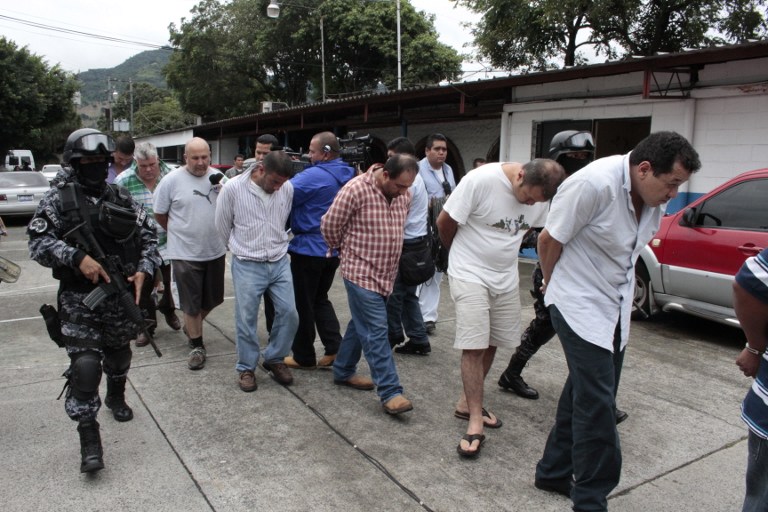AFP photo
By
Ricardo Swire
As the War on Drugs reverberates around the region several Mexican drug cartels have expanded their smuggling routes, establishing new markets in Central America.
Mexican migration mostly to El Salvador, Guatemala and Honduras has contributed to the highest murder rate in the hemisphere. El Salvador’s internal security reports mention evidence of the 18th Street Gang, Mara Salvatrucha (MS-13) and Texis Cartel working in sync with “Mexican Mafia” emissaries. In 2005 a clique of 18th Street Gang members splintered and two factions the “Revolutionaries” and “Surenos” evolved.
MS-13 representatives dominate Las Victorias barrio, just 8.6 kilometers from the capital San Salvador. In May 2015 Salvadorian National Civil Police (PNC) elite “FES” officers raided the La Capanera district of the Soyapango commercial center. Several internal security intelligence reports indicate the Western Union wire transfer service provided by Banco Hipotecario, Centro Comercial Unicentro, #55c Y56c in Soyapango attracts money launderers. After the 2015 PNC sting 34 18th Street Gang affiliates were arrested, mobile phones, police uniform pants, jackets, caps and gun holsters discovered.
El Salvador’s “Maras” or Street Gangs supply transient Mexican traffickers with illegal weapons, communication platforms and local “foot soldiers.” On January 18, 2012 at 6:42pm INTERPOL’s Washington bureau sent an “URGENT” fax to its San Salvador workforce. The document advised that a Texis Cartel executive member known as “El Burro” is wanted by two American Federal agencies. El Burro is a Salvadorian US citizen, arrested seven times in California and Texas charged with carrying weapons, attempted robbery, possession of a stolen vehicle and aggravated assault with a weapon.
An April 2012 three page Salvadoran Center for Police Intelligence document verified the Texis Cartel’s headquarters in Metapan, Santa Ana. The criminal group also dominates the Texistepeque district northwest of San Salvador. The Texis Cartel works mainly with Guatemalan and Colombian traffickers. A senior member manages the special route from Honduras via northwestern El Salvador to Guatemala.
In 2014 America’s Drug Enforcement Administration (DEA) formally named Texis Cartel’s top executive Chepe Diablo as a drug trafficker and money launderer. Part of a domestic criminal probe the same year mandated “Hotesa S.A,” a Chepe Diablo company, to pay El Salvador’s Treasury US$231,000 in tax evasion fines. 2010 and 2011 Treasury records showed Hotesa S.A diverted US$834,721.55 and $274,940.25 of national taxes respectfully.
The Salvadorian Kingpin began his career in 1990 with a small investment brokerage. Five other corporate entities including agribusiness giant Gumarsal, a hotel chain and Metapanecos Trading’s six service stations added to Chepe Diablo’s portfolio. In June 2000 the Texis Cartel leader and two associates registered the Montecristo Development Society, declaring the buying and selling of real estate as core business. Evidence dictates Chepe Diablo used such corporate units for tax evasion and money laundering purposes.
According to El Salvador’s Register of Commerce between 2004 and 2013 Gumarsal purchased grain from Archer Midland Daniels (AMD) in Decatur, Illinois, USA. Between 2008 and 2009 the company additionally spent US$7.7 million with the Global Commodities Trading Consortium based in Granite Bay, California. Metapanecos Trading imported oil from Chevron Corporation headquartered in San Ramon, California.
El Salvador Treasury Department’s 2016 figures highlighted one named Chepe Diablo conglomerate that possessed US$60 million worth of revenue. In March 2017 PNC officers intercepted one hundred and sixty kilos of cocaine outside the capital, dispatched by Texis Cartel traffickers. On April 4, 2017 Chepe Diablo was detained during a major law enforcement operation, fifty properties including the gas stations, hotels and shops owned or operated by the Texis Cartel chief raided.



No Comments Yet!
You can be first to comment this post!